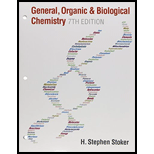
Concept explainers
On the basis of the given information, determine the numerical value of the subscript x in each of the following chemical formulas.
- a. BaS2Ox; formula unit contains 6 atoms
- b. Al2(SOx)3; formula unit contains 17 atoms
- c. SOxClx; formula unit contains 5 atoms
- d. CxH2xClx; formula unit contains 8 atoms
(a)
Interpretation:
The value of subscript “x” in the given chemical formula,
Concept Introduction:
The composition of a chemical compound can be presented in a very precise was with the use of chemical formula. Chemical formula uses chemical symbols of the elements that is present in the compound and numerical subscripts that represent how many number of atoms of each element is present in the compound.
Answer to Problem 1.85EP
The value of subscript “x” is found to be 3.
Explanation of Solution
Given molecule is
Considering this the value of “x” can be found out as shown below,
The value of subscript “x” is found to be 3. The chemical formula can be given as
Value of subscript “x” is determined.
(b)
Interpretation:
The value of subscript “x” in the given chemical formula,
Concept Introduction:
The composition of a chemical compound can be presented in a very precise was with the use of chemical formula. Chemical formula uses chemical symbols of the elements that is present in the compound and numerical subscripts that represent how many number of atoms of each element is present in the compound.
Answer to Problem 1.85EP
The value of subscript “x” is found to be 4.
Explanation of Solution
Given molecule is
Considering this the value of “x” can be found out as shown below,
The value of subscript “x” is found to be 4. The chemical formula can be given as
Value of subscript “x” is determined.
(c)
Interpretation:
The value of subscript “x” in the given chemical formula,
Concept Introduction:
The composition of a chemical compound can be presented in a very precise was with the use of chemical formula. Chemical formula uses chemical symbols of the elements that is present in the compound and numerical subscripts that represent how many number of atoms of each element is present in the compound.
Answer to Problem 1.85EP
The value of subscript “x” is found to be 2.
Explanation of Solution
Given molecule is
Considering this the value of “x” can be found out as shown below,
The value of subscript “x” is found to be 2. The chemical formula can be given as
Value of subscript “x” is determined.
(d)
Interpretation:
The value of subscript “x” in the given chemical formula,
Concept Introduction:
The composition of a chemical compound can be presented in a very precise was with the use of chemical formula. Chemical formula uses chemical symbols of the elements that is present in the compound and numerical subscripts that represent how many number of atoms of each element is present in the compound.
Answer to Problem 1.85EP
The value of subscript “x” is found to be 2.
Explanation of Solution
Given molecule is
Considering this the value of “x” can be found out as shown below,
The value of subscript “x” is found to be 2. The chemical formula can be given as
Value of subscript “x” is determined.
Want to see more full solutions like this?
Chapter 1 Solutions
Bundle: General, Organic, and Biological Chemistry, 7th + OWLv2 Quick Prep for General Chemistry, 4 terms (24 months) Printed Access Card
- AE>AE₁ (Y/N) AE=AE₁ (Y/N) AEarrow_forwardTreatment of 2-phenylpropan-2-amine with methyl 2,4-dibromobutanoate in the presence of a nonnucleophilic base, R3N, involves two successive SN2 reactions and gives compound A. ? NH2 Br Br Propose a structural formula for compound A. You do not have to explicitly draw H atoms. You do not have to consider stereochemistry. In cases where there is more than one answer, just draw one. R3N C14H19NO2 + 2 R3NH*Br Aarrow_forwardCorrectly name this compound using the IUPAC naming system by sorting the components into the correct order. Br IN Ν Harrow_forwardHow is the radical intermediate for this structure formed? Can you please draw arrows from the first radical to the resonance form that would result in this product? I'm lost.arrow_forwardPart VI. (a) calculate the λ max of the compound using woodward - Fieser rules. (b) what types of electronic transitions are present in the compound? (c) what are the prominent peaks in the IR spectrum of the compound?arrow_forwardDon't used Ai solutionarrow_forwardPlease correct answer and don't used hand raitingarrow_forward↑ 0 Quiz List - RCC430M_RU05 X Aktiv Learning App × Qdraw resonance structure ×Q draw resonance structure xb My Questions | bartleby ×+ https://app.aktiv.com Draw a resonance structure of pyrrole that has the same number of pi bonds as the original structure. Include all lone pairs in your structure. + N H a 5 19°F Cloudy Q Search Problem 12 of 15 Atoms, Bonds and Rings Charges and Lone Pairs myhp हजु Undo Reset Remove Done Submit Drag To Pan 2:15 PM 1/25/2025arrow_forwardDon't used hand raitingarrow_forwardarrow_back_iosSEE MORE QUESTIONSarrow_forward_ios
 Introductory Chemistry: A FoundationChemistryISBN:9781337399425Author:Steven S. Zumdahl, Donald J. DeCostePublisher:Cengage Learning
Introductory Chemistry: A FoundationChemistryISBN:9781337399425Author:Steven S. Zumdahl, Donald J. DeCostePublisher:Cengage Learning World of Chemistry, 3rd editionChemistryISBN:9781133109655Author:Steven S. Zumdahl, Susan L. Zumdahl, Donald J. DeCostePublisher:Brooks / Cole / Cengage Learning
World of Chemistry, 3rd editionChemistryISBN:9781133109655Author:Steven S. Zumdahl, Susan L. Zumdahl, Donald J. DeCostePublisher:Brooks / Cole / Cengage Learning Chemistry: Principles and PracticeChemistryISBN:9780534420123Author:Daniel L. Reger, Scott R. Goode, David W. Ball, Edward MercerPublisher:Cengage Learning
Chemistry: Principles and PracticeChemistryISBN:9780534420123Author:Daniel L. Reger, Scott R. Goode, David W. Ball, Edward MercerPublisher:Cengage Learning ChemistryChemistryISBN:9781305957404Author:Steven S. Zumdahl, Susan A. Zumdahl, Donald J. DeCostePublisher:Cengage Learning
ChemistryChemistryISBN:9781305957404Author:Steven S. Zumdahl, Susan A. Zumdahl, Donald J. DeCostePublisher:Cengage Learning






